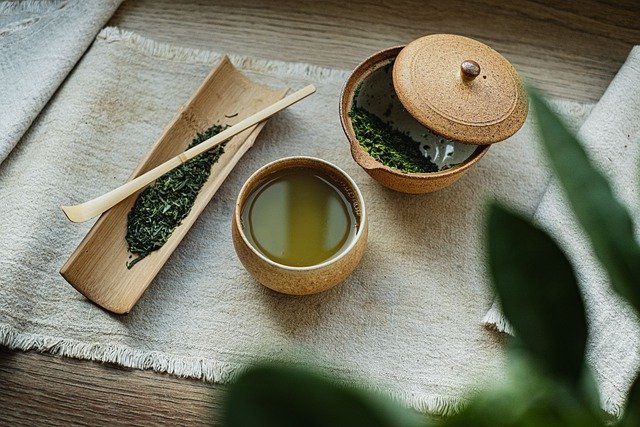
Green tea has a strong antioxidant action useful for counteracting the action of free radicals, responsible for aging and diseases
Green tea ( Camellia sinensis ) belongs to the Theaceae family. Well known for its antioxidant action, it is useful for counteracting cellular aging.
Properties of green tea
Green tea boasts numerous properties which can be summarized as follows:
- Antioxidant;
- anti-inflammatory;
- stimulant for the central nervous system;
- diuretic;
- lipolytic;
- hypocholesterolemic;
- slimming;
- protective on blood vessels;
- antidiarrheal.
The properties are given by the presence of numerous compounds in green tea leaves including caffeine (commonly called theine) and phenolic compounds (phenolic acids, tannins , flavonoids , etc.) as well as proteins, carbohydrates, vitamin C and other active ingredients.
What is green tea used for
Green tea is a drink with a thousand-year use, especially appreciated as a stimulant and tonic against tiredness, stress and excessive fatigue.
Green tea herbal tea is also an excellent thirst-quenching drink with diuretic properties, used as an adjutant in low-calorie diets to lose weight and in case of diarrhea.
Consumed in a habitual way, green tea is able to protect against the harmful action of free radicals, slow down the cellular aging process, preserve cognitive functions.
The antioxidant and anti-inflammatory properties of green tea can also help protect blood vessels, reduce cholesterol levels and help prevent the risk of cardiovascular disease.
Benefits of green tea
The young leaves of green tea contain the highest percentage of antioxidant principles found in nature, useful for counteracting the formation of free radicals, responsible for cellular aging. The polyphenols present are anti-radicals, more powerful even than vitamins C and E.
The antioxidant action is mainly given by the flavonoids and in particular by the catechins which help to support cardiac functions and contribute to maintaining a good state of health.
These substances also reduce the levels of LDL cholesterol and triglycerides, thus exerting a protective action against cardiovascular diseases, including atherosclerosis and coronary heart disease.
The antioxidant action of green tea seems to help prevent the onset of tumors.
Regular consumption of green tea can also help protect brain cells from damage typical of neurodegenerative diseases and prevent the onset of Parkinson’s disease and Alzheimer’s syndrome.
The synergistic action of the polyphenolic derivatives has superior antidegerenative properties compared to that of the single active ingredients, confirming the thesis according to which the plant phytocomplex is much more active than the single isolated and purified components.
Another interesting property attributed to green tea is that of slimming. Green tea infusions are often used as adjuvants for weight loss due to the stimulating action of tea on the basal metabolism and for the ability of this remedy to promote the mobilization of glycogen, the oxidation of fats and to increase lipolysis.
How to use
Infusion
1 tablespoon of green tea leaves or 1 teaspoon of powdered green tea in a cup of water, steep for ten minutes. They drink 3 to 5 cups a day.
Green tea extract
600-800 mg of dry extract of the leaves in the form of tablets or capsules.
When to drink green tea
You can drink green tea every day, at any time of the day: at breakfast, during mid-morning or mid-afternoon breaks.
Instead, it is better not to consume green tea with meals, especially for anemic people, since the polyphenols present in tea leaves can reduce the absorption of iron.
People who are particularly sensitive to the stimulating action of caffeine may experience agitation and insomnia problems if green tea is consumed in the late afternoon or evening.
How much green tea to drink per day
To enjoy the benefits of green tea, the ideal would be to drink 300 to 500 milliliters of green tea per day.
Who can’t drink green tea
Green tea can be consumed safely by most of the population, barring allergies.
Contraindications
Green tea has no particular side effects or contraindications. However, the abuse, that is, prolonged use and at high doses, can cause anxiety, nervousness, insomnia , gastrointestinal problems and liver pain.
As for green tea and thyroid, since green tea stimulates the thyroid function, it is good to be careful and not to overeat.
Description of the plant
In its natural state it can grow well over two meters but, to facilitate its cultivation, it generally remains at the size of an evergreen bush or shrub. The leaves are ovate-sharp, with the toothed margin, of a bright light green color. The flowers, simple and small, with 7-8 petals, are white and bear numerous golden-yellow stamens.
Green tea habitat
Native to the continental part of South and Southeast Asia, today it is cultivated all over the world, especially in tropical and subtropical climate regions.
Background

The botanical name Camellia was given genus in honor of the contribution that the reverend Georg Joseph Kamel known as Camellus (1661-1706), famous botanist, gave to science; instead The name sinensis in Latin means ” Chinese “.
In addition to the variety and cultural differences, the various types of tea are classified according to the processing process to which they are subjected. In particular, while in the preparation of black tea fermentation is essential to obtain the desired aroma, green tea is obtained from young and fresh leaves, treated in such a way as to inhibit fermentation processes.
Compared to black tea, green tea is lower in caffeine (about 50% less), but has more antioxidant properties. In addition, there are several varieties of tea on the market, from Chinese green tea to Japanese green teas such as bancha and sencha, from tea blends to flavored teas.
Already in ancient times, Traditional Chinese Medicine knew its virtues and attributed the power to heal headaches, eliminate toxins and preserve youth.
It is said that the Chinese emperor Shen Nung was the first tea drinker; Historical data dates back to 2700 BC, when the emperor, by putting the leaves of the plant in a jug of boiling water, began a ritual as healthy as it is sacred.
